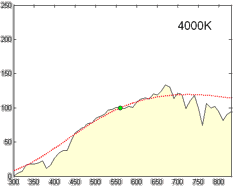Full-spectrum light is light that covers the electromagnetic spectrum from infrared to near-ultraviolet, or all wavelengths that are useful to plant or animal life; in particular, sunlight is considered full spectrum, even though the solar spectral distribution reaching Earth changes with time of day, latitude, and atmospheric conditions.
"Full-spectrum" is not a technical term when applied to an electrical light bulb. Rather, it implies that the product emulates some important quality of natural light.[1]
Products marketed as "full-spectrum" may produce light throughout the entire visible spectrum, but without producing an even spectral distribution. Some may not differ substantially from lights not marketed as "full-spectrum".[1][2]

- ^ a b "Full-spectrum Light Sources". Lighting Answers. Vol. 7, no. 5. March 2005 [September 2003]. Retrieved 2007-11-01.
- ^ Galidakis, I.N. "The Double Amici Prism Hand-Held Spectroscope". Retrieved 2007-11-01.
© MMXXIII Rich X Search. We shall prevail. All rights reserved. Rich X Search
